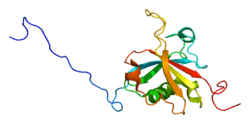SAP18
Histone deacetylase complex subunit SAP18 is an enzyme that in humans is encoded by the SAP18 gene.[1][2]
Function
Histone acetylation plays a key role in the regulation of eukaryotic gene expression. Histone acetylation and deacetylation are catalyzed by multisubunit complexes. The protein encoded by this gene is a component of the histone deacetylase complex, which includes SIN3, SAP30, HDAC1, HDAC2, RbAp46, RbAp48, and other polypeptides. This protein directly interacts with SIN3 and enhances SIN3-mediated transcriptional repression when tethered to the promoter.[2] Additionally, SAP18s splice variants are implicated in apoptotic cycles.[3]
Interactions
SAP18 has been shown to interact with
References
- ↑ Zhang Y, Iratni R, Erdjument-Bromage H, Tempst P, Reinberg D (Jun 1997). "Histone deacetylases and SAP18, a novel polypeptide, are components of a human Sin3 complex". Cell 89 (3): 357–64. doi:10.1016/S0092-8674(00)80216-0. PMID 9150135.
- ↑ 2.0 2.1 "Entrez Gene: SAP18 Sin3A-associated protein, 18kDa".
- ↑ Michelle L, Cloutier A, Toutant J, Shkreta L, Thibault P, Durand M, Garneau D, Gendron D, Lapointe E, Couture S, Le Hir H, Klinck R, Abou Elela S, Prinos P, Chabot B (December 2011). "Proteins Associated with the Exon Junction Complex Also Control the Alternative Splicing of Apoptotic Regulators". Mol Cell Biol 32 (5): 954–67. doi:10.1128/MCB.06130-11. PMC 3295189. PMID 22203037.
- ↑ Wada M, Miyazawa H, Wang RS, Mizuno T, Sato A, Asashima M, Hanaoka F (March 2002). "The second largest subunit of mouse DNA polymerase epsilon, DPE2, interacts with SAP18 and recruits the Sin3 co-repressor protein to DNA". J. Biochem. 131 (3): 307–11. doi:10.1093/oxfordjournals.jbchem.a003104. PMID 11872158.
- ↑ Cheng SY, Bishop JM (April 2002). "Suppressor of Fused represses Gli-mediated transcription by recruiting the SAP18-mSin3 corepressor complex". Proc. Natl. Acad. Sci. U.S.A. 99 (8): 5442–7. doi:10.1073/pnas.082096999. PMC 122788. PMID 11960000.
- ↑ Ewing RM, Chu P, Elisma F, Li H, Taylor P, Climie S, McBroom-Cerajewski L, Robinson MD, O'Connor L, Li M, Taylor R, Dharsee M, Ho Y, Heilbut A, Moore L, Zhang S, Ornatsky O, Bukhman YV, Ethier M, Sheng Y, Vasilescu J, Abu-Farha M, Lambert JP, Duewel HS, Stewart II, Kuehl B, Hogue K, Colwill K, Gladwish K, Muskat B, Kinach R, Adams SL, Moran MF, Morin GB, Topaloglou T, Figeys D (2007). "Large-scale mapping of human protein-protein interactions by mass spectrometry". Mol. Syst. Biol. 3 (1): 89. doi:10.1038/msb4100134. PMC 1847948. PMID 17353931.
Further reading
- Koipally J, Renold A, Kim J, Georgopoulos K (1999). "Repression by Ikaros and Aiolos is mediated through histone deacetylase complexes". EMBO J. 18 (11): 3090–100. doi:10.1093/emboj/18.11.3090. PMC 1171390. PMID 10357820.
- Wada M; Miyazawa H; Wang RS et al. (2002). "The second largest subunit of mouse DNA polymerase epsilon, DPE2, interacts with SAP18 and recruits the Sin3 co-repressor protein to DNA". J. Biochem. 131 (3): 307–11. doi:10.1093/oxfordjournals.jbchem.a003104. PMID 11872158.
- Cheng SY, Bishop JM (2002). "Suppressor of Fused represses Gli-mediated transcription by recruiting the SAP18-mSin3 corepressor complex". Proc. Natl. Acad. Sci. U.S.A. 99 (8): 5442–7. doi:10.1073/pnas.082096999. PMC 122788. PMID 11960000.
- Strausberg RL; Feingold EA; Grouse LH et al. (2003). "Generation and initial analysis of more than 15,000 full-length human and mouse cDNA sequences". Proc. Natl. Acad. Sci. U.S.A. 99 (26): 16899–903. doi:10.1073/pnas.242603899. PMC 139241. PMID 12477932.
- Paces-Fessy M, Boucher D, Petit E, Paute-Briand S, Blanchet-Tournier MF (March 2004). "The negative regulator of Gli, Suppressor of fused (Sufu), interacts with SAP18, Galectin3 and other nuclear proteins". Biochem. J. 378 (Pt 2): 353–62. doi:10.1042/BJ20030786. PMC 1223961. PMID 14611647.
- Andersen JS, Lam YW, Leung AK, Ong SE, Lyon CE, Lamond AI, Mann M (January 2005). "Nucleolar proteome dynamics". Nature 433 (7021): 77–83. doi:10.1038/nature03207. PMID 15635413.
External links
- SAP18 human gene location in the UCSC Genome Browser.
- SAP18 human gene details in the UCSC Genome Browser.
| |||||||||




